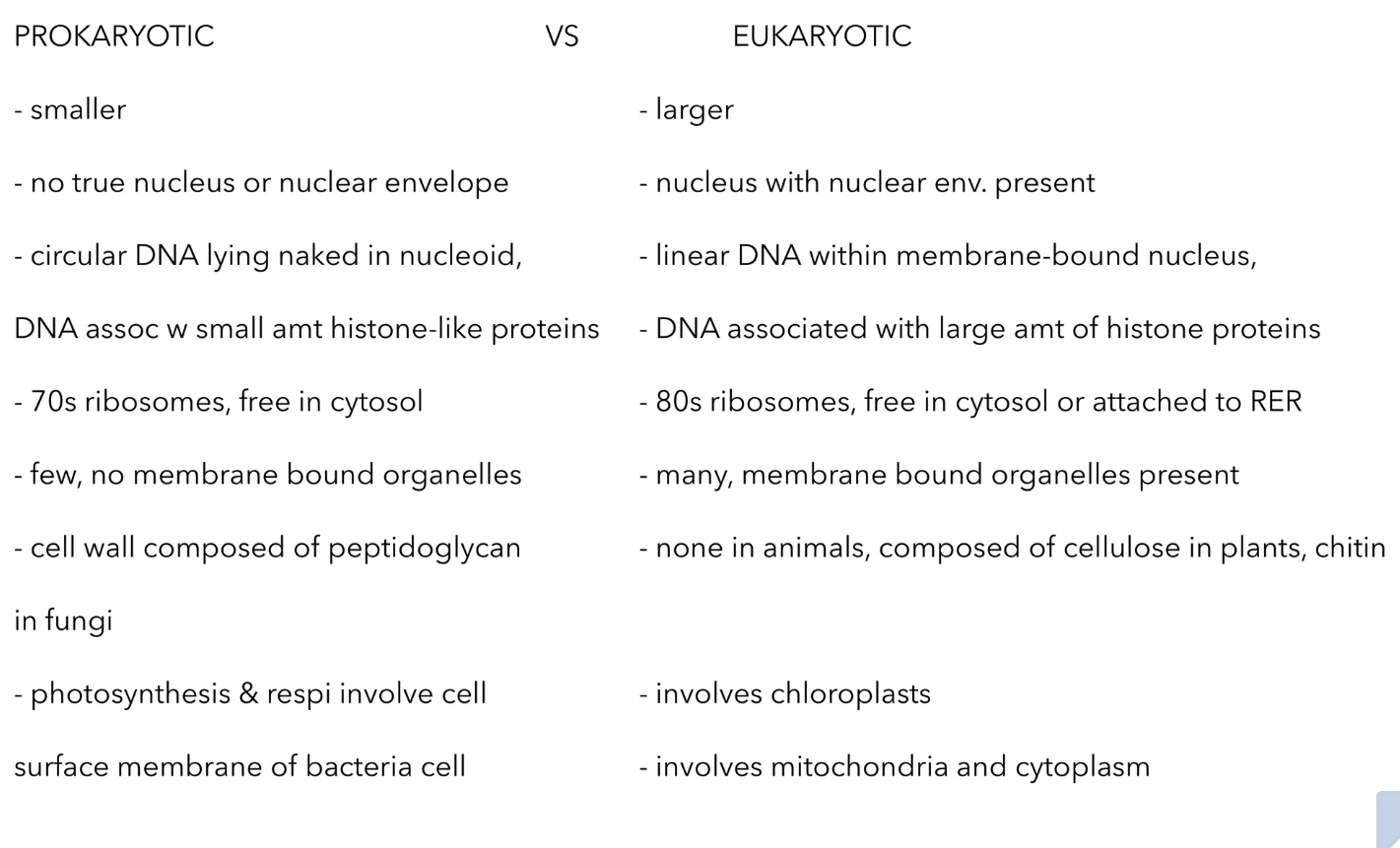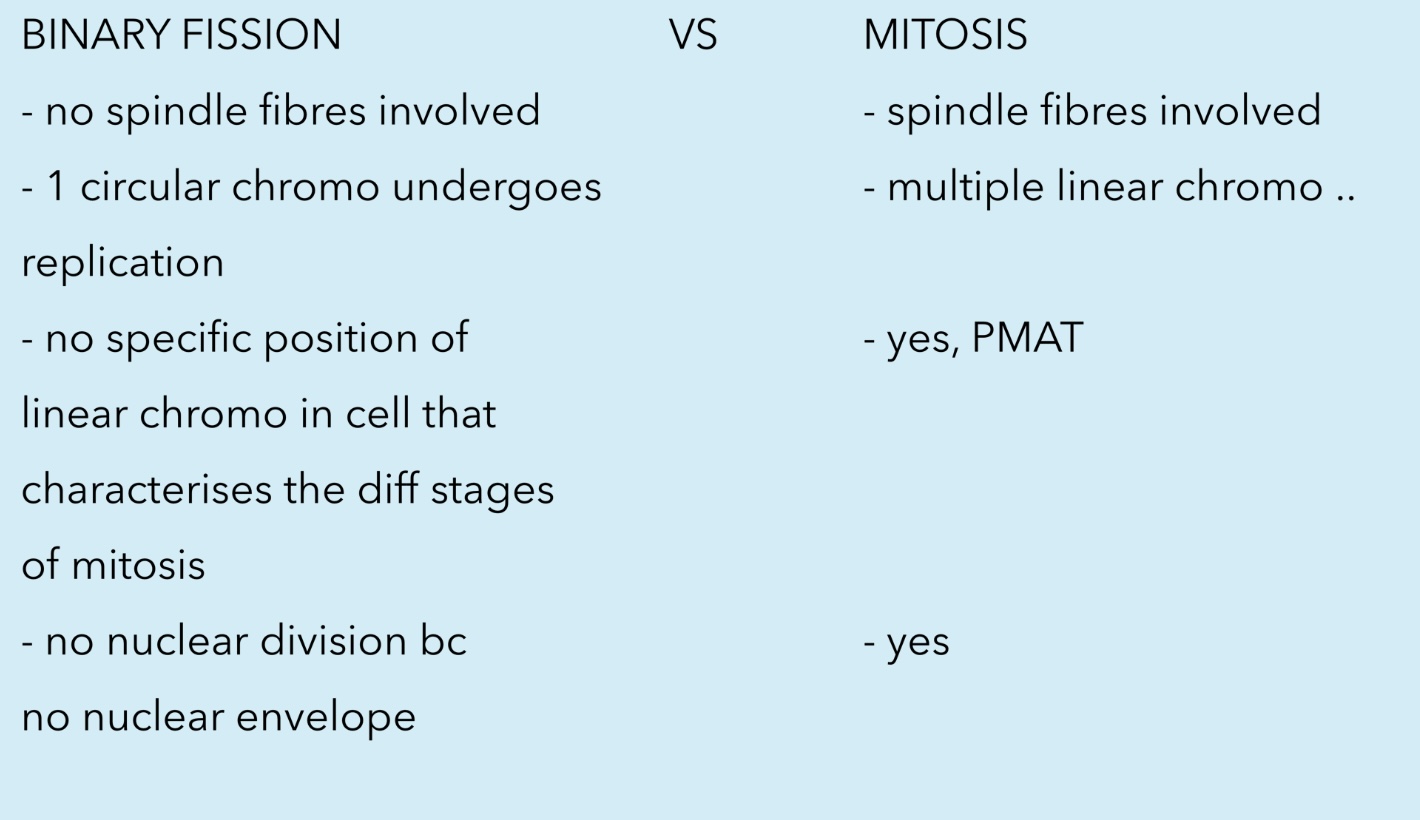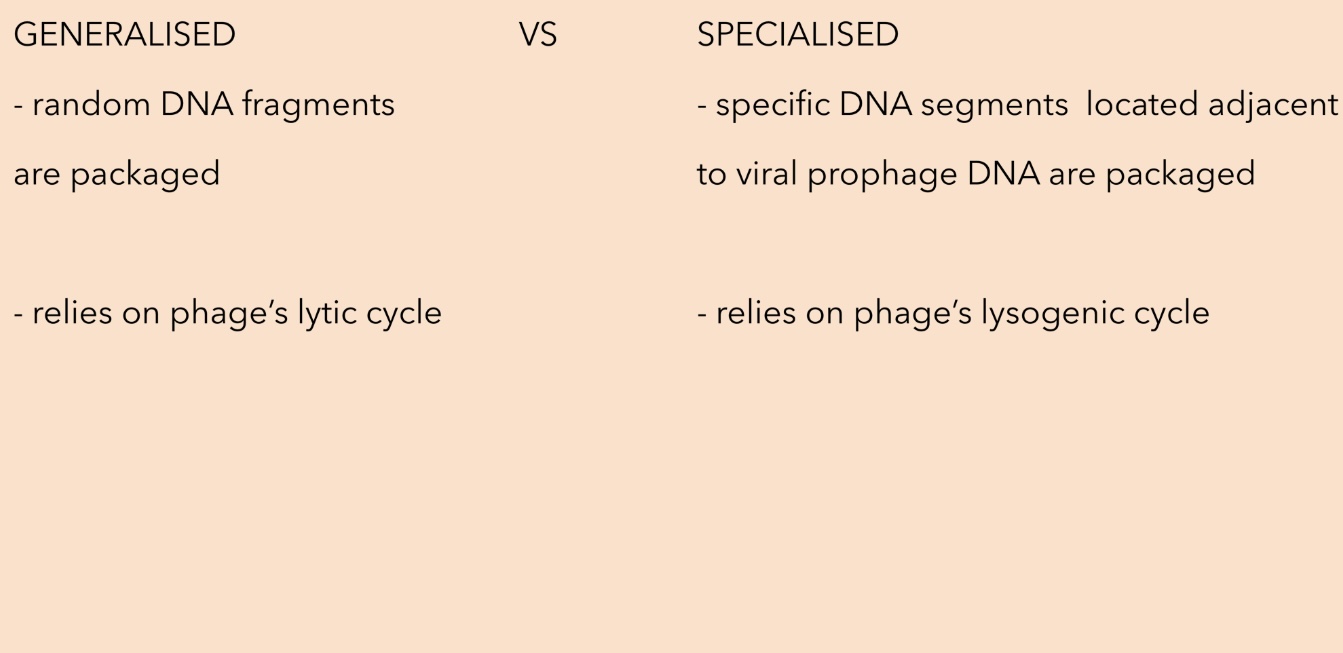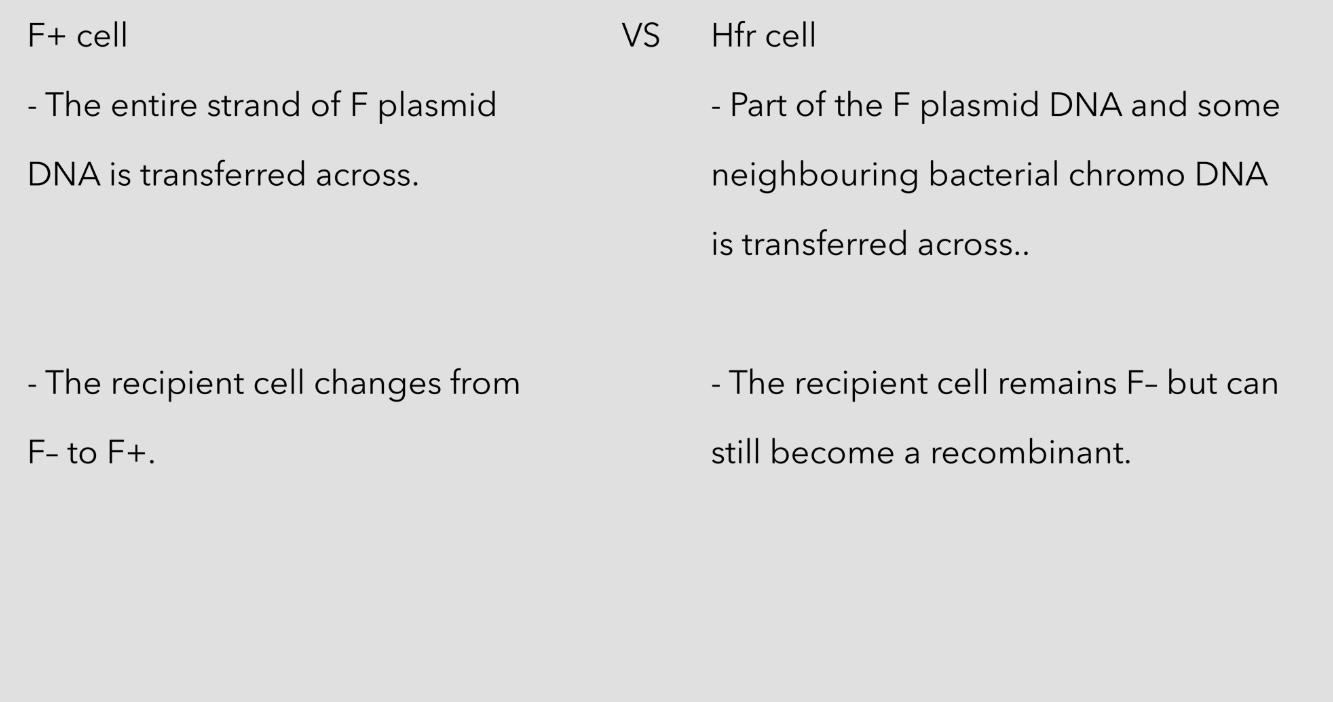BACTERIA
1/48
There's no tags or description
Looks like no tags are added yet.
Name | Mastery | Learn | Test | Matching | Spaced |
|---|
No study sessions yet.
49 Terms
define binary fission
It is the asexual means by which bacterial cells produce genetically identical offspring.
define transformation
it is the uptake of naked foreign DNA fragments from the surrounding environment, resulting in a change of the bacterial cell’s genotype and phenotype.
define conjugation
it is the direct transfer of genetic material from one bacterial cell to another, through a temporary link between the 2 cells
NOTE:
- transfer of DNA is always one-way, from donor cell with F plasmid to recipient cell without F plasmid
define general transduction
It is a processs where bacteriophages randomly carry bacterial genes from one host cell to a recipient cell as a result of aberrations in the bacteriophage reproductive cycle. They then introduce these foreign genes to another bacterium cell.
define specialised transduction
It is the process where bacterial DNA that is transferred is restricted to bacterial genes that are directly adjacent to the integrated prophage.
- carried out by temperate phages that undergo the lysogenic cycle to integrate their genome into the bacterial chromo, forming a prophage
BACTERIAL STRUCTURE VS EUKARYOTIC STRUCTURE?
- cell size
- nucleus
- genetic material
- ribosomes
- organelles
- cell wall
- photosynthesis
- respiration

general nucleoid structure?
- dense region in cytoplasm of the bacterial cell where chromosomal DNA is generally confined
- not bound by a membrane but is visibly distinct from the rest of the cell interior
- main component of bacterial genome -> ds, circular DNA molecule associated with histone-like proteins
- DNA forms loop domains that are anchored by proteins, followed by further supercoiling to form highly condensed DNA
- no introns in the chromo
general nucleoid function?
- contains bacteria’s genetic material
- regulates processes of the cell such as growth and reproduction
general structure of ribosomes?
- 70s made up of 50s large and 30s small ribosomal subunits
- they give the cytoplasm a granular appearance in electron micrographs
general function of ribosomes?
- site of protein synthesis
general function of storage granules?
- stores nutrients and chemicals such as glycogen, lipids, mineral ions eg phosphorous and magnesium
general structure of plasmids?
- small, circular, autonomously replicating DNA molecules
- may contain genes which confer advantages on bacteria living in stressful environments
- multiple copies present in a cell
- bacterial genome consists of chromosomal DNA + plasmid DNA
general function of plasmids?
- plasmids are used in genetic engineering as vectors for introducing and expressing foreign DNA in bacterial cells
- plays a role in conjugation, where genetic material is transferred through the sex pilus from cell to cell
general structure of cell surface membrane?
- comprised of phospholipid bilayer
- site of electron transport chains. enzymes involved in respiration and photosynthesis are embedded in the membrane to produce ATP
- cell membrane folds inwards to form mesosome, increasing SA for embedded enzymes to carry out respiration
general function of cell surface membrane?
- selectively permeable barrier, controls the movement of substances in and out of the cell
- site of metabolic reactions including respiration and photosynthesis
general structure of cell wall?
- consists of peptidoglycan
general function of cell wall?
- protects cell from osmotic lysis
general structure of glycocalyx / capsule?
- surrounds cell wall
- glycocalyx
1) distinct layer — referred to as capsule 2) diffused layer — slime layer
- capsule may contain proteins for recognition and adhesion
general structure of flagella + singular?
- singular: flagellum
- hollow cylindrical protein thread that propels the bacterium by rotation
NOTE: some bacteria possess more than 1 flagellum and they may be found distributed all over the cell
general function of flagella?
- long appendage for mobility
general structure of fimbriae + singular term?
- singular: fimbria
- short, bristle-like fibres extending from cell surface
- usually evenly distributed over the entire cell surface or at poles of cell
general function of fimbriae?
- for attachment to surfaces or other organisms/bacteria
general structure of pili + singular term?
- singular: pilus
- longer and fewer in number than fimbriae
general function of pili?
function: involved in mobility and DNA transfer
- mobility -> pilus makes contact with a surface and retracts to pull the bacteria forward in a jerky, intermittent movement
- DNA transfer through conjugation -> sex pilus allows 2 bacterial cells to be drawn close to each other, to form a mating bridge. genetic material is then transferred from one bacterium to another
[ABI] distinguish between single and double membraned organelles in eukaryotic cells

how does binary fission differ from mitosis?

generalised transduction VS specialised transduction?

vertical gene transfer vs horizontal gene transfer?
- VERTICAL GENE TRANSFER -> transmission of genes from parent to offspring during binary fission
- HORIZONTAL GENE TRANSFER -> transfer of genetic material between unrelated organisms, through transformation, (generalised and specialised) transduction, and conjugation
conjugation in F+ and F- VS conjugation in Hfr cells and F-
- type of DNA transferred to recipient
- subsequent change in genotype of recipient cell

describe how bacterial chromo replication occurs
1) At the ori site, double helix separates to form replication bubble made up of 2 single DNA strands. Replication continues in both directions away from the origin, forming 2 repli forks. Each repli fork will have 1 leading strand and 1 lagging strand being synthesised.
2) As the chromo replicates, the 2 newly formed ori move to opposite poles of the cell and attach to the CSM. The cell elongates to prepare for division.
3) As DNA is circular, an interlocking structure made up of the 2 daughter DNA molecules will be formed upon repli completion. Enzyme topoisomerase is needed to cut, separate and reseal the 2 DNA molecules.
4) When the daughter DNA molecules are separated, the bacterium will have reached twice its initial size. Invagination of CSM and the deposition of new cell wall, eventually divide the parent cell into 2 daughter cell, with each inheriting a complete, genetically identical genome.
describe how generalised transduction occurs.
1) When a phage undergoes the lytic cycle, after infecting a bacterium and injecting its phage DNA genome into the bacterium, phage enzymes may hydrolyse the host bacterial chromo into small fragments of DNA that may contain genes.
2) During assembly of new viruses, the phage genome is packaged in the phage capsid. However, instead of the viral genome, a small fragment of the host bacterium cell’s degraded DNA may be randomly packaged within the capsid head, resulting in a defective phage.
3) Following lysis of the host cell, the defective phage is released and can infect another bacterium. The piece of bacterial DNA acquired from the host cell is injected into the recipient cell.
-> If crucial viral genes have been replaced by bacterial genes in the defective phage, it might be that no new phages can be synthesised in the recipient cell.
-> If homologous recombination takes place, the foreign DNA from the donor cell can subsequently replace the homologous region of the recipient cell’s chromosome.
4) The recipient cell with the new allele integrated into its genome becomes a recombinant cell, which expresses the new allele. It has a different genotype from both donor and original recipient cells.
describe how transformation occurs
1) Foreign DNA fragments are present from lysed neighbouring cells in the medium.
-> Competent cells possess CSM proteins that can bind to and transport the foreign DNA fragments into the cell.
-> Cells that are not competent can be made artificially competent through immersion in a culture medium with high concentrations of CaCl2 followed by a heat shock treatment.
2) The foreign DNA can be incorporated into the bacterial chromosome through genetic exchange at 2 homologous regions of the bacterial chromo. This process is known as homologous recombination. If no homologous recombination occurs, the foreign DNA will not be incorporated into the chromo but will be degraded.
3) The resultant cell is a recombinant cell. If diff alleles for a gene were exchanged, there will be a permanent change in the organism’s phenotype as the new allele is expressed. The bacterium’s recombinant genome will be passed on to all subsequent offspring through binary fission.
describe how specialised transduction occurs.
1) Temperate phage infects the host bacterial cell and injects its DNA genome into host cell.
2) Phage DNA integrates into the bacterial chromo, forming a prophage, hence phage enters lysogenic pathway. As the cell divides by binary fission, a single infected cell can give rise to a large population of bacteria carrying the prophage.
3) Upon induction, the prophage exits the bacterial chromosome, switching from the lysogenic cycle to the lytic cycle, but the viral DNA is improperly excised, such that bacterial DNA adjacent to the prophage is excised as well.
4) The phage-host hybrid DNA is replicated and packaged into capsid heads of new viral progeny during assembly. All the viral progeny, which are recombinant phages, released after bacterial cell lysis are capable of infecting other bacteria.
5) The recombinant phage then infects another new host cell and injects its DNA genome and bacterial DNA from previous host bacterial cell.
6) New alleles can be incorporated into the bacterial chromosome of recipient cell by either
-> homologous recombination at homologous regions as the bacterial DNA from previous host cell replaces the homologous region in the recipient cell’s chromosome
-> integration of the phage-bacterial hybrid DNA into chromo of recipient cell, as defective phage enters the lysogenic cycle
describe how conjugation occurs.
1) Conjugation begins when sex pilus on the surface of an F+ cell attaches to an F– cell.
2) After the sex pilus attaches, it retracts, pulling the two cells closer. A mating bridge is then formed between the two cells (NOT formed from sex pilus). A single strand of F plasmid is nicked and transferred from F+ cell to F– cell via the mating bridge and is replicated via the rolling circle DNA replication.
3) The single strand of plasmid DNA in the recipient cell re-circularises and serves as template for the synthesis of a complementary daughter stand.
4) Through semi-conservative replication, both cells now contain a double-stranded F plasmid. F– cell now becomes a F+ cell.
describe how rolling circle DNA replication occurs.
1) For the transfer to take place, one strand of the double-stranded F plasmid is nicked by a nuclease.
2) The free 3’-OH end of the nicked strand is extended by DNA polymerase for the synthesis of a new complementary strand using the intact strand as the template.
3) The newly synthesized DNA strand displaces the nicked strand as it is extended; the now displaced nicked strand is transferred via the 5’ end to the recipient cell concurrently across the mating bridge.
4) The nicked strand serves as a template for synthesis of a complementary DNA strand in the recipient cell to form double-stranded F plasmid DNA
what is the F factor and what can it do?
- The F factor is a segment of DNA on the F plasmid, that carries genes coding for proteins, that are necessary for the formation of the sex pilus
— Due to the F factor, the donor cell is able to produce sex pilus to attach itself to the recipient cell
NOTE:
- donor cell with F plasmid called F+ cell
- recipient cell without F plasmid called F- cell
define an operon.
- An operon is a cluster of genes with related functions.
- It includes a common promoter, an operator, and more than one structural genes that are controlled as a unit to produce a single polycistronic mRNA.
What benefits are there for the bacteria to regulate its genes?
1) Allows for functionally related proteins to be synthesised simultaneously, saving energy and resources
2) Economic use of energy and resources -> gene expressed and protein produced only when necessary
3) Enables bacteria to respond appropriately and rapidly to changes in the environment
—> ability to do the above confers a selective advantage to such bacteria over those that cannot regulate gene expression
What are the functions of the operator, regulatory gene and structural gene?
- Operator -> is a site on DNA which a repressor protein binds to, to prevent transcription from initiating at the adjacent promoter
- Regulatory gene -> codes for a protein that is involved in the regulation of the expression of other genes eg lac repressor & CAP
- Structural gene -> any gene that codes for a protein product that forms part of a structure, or has a metabolic function
Define polycistronic mRNA.
- It is a single mRNA strand that codes for several polypeptides. Each section of the mRNA strand has its own start and stop codons.
What kind of operon is the lac operon?
What are its 3 structural genes, in order, and what do they code for?
What are the functions of their protein products?
It is an inducible operon. The 3 genes are usually not expressed but can be induced and expressed in the presence of an inducer molecule.
- The 3 structural genes are lacZ, lacY and lacA.
- lacZ codes for β-galactosidase, which hydrolyses lactose to glucose and galactose. It also converts lactose to allolactose (isomerisation)
- lacY codes for permease, which is a membrane transport protein that enables cells to take up lactose efficiently.
- lacA codes for transacetylase, and its role in the lac operon remains unclear.
How is the lac operon negatively regulated?
(default mode)
1) The regulatory gene lacI, is constitutively transcribed, resulting in continued production of small amounts of the lac repressor protein.
2) The repressor protein is produced in the active form and binds specifically to the lac operator sequence via its DNA-binding site.
3) In the absence of lactose, the repressor binds to the operator, denying RNA polymerase access to the promoter.
4) Transcription of the structural genes in the lac operon is hence repressed.
NOTE: This is the default mode of the lac operon (absence of lactose & glucose)
- binding of repressor to the operator is mediated by weak interactions, thus the repressor sometimes dissociates from the operator, resulting in basal level of lac operon products
How is the lac operon induced?
(negative regulation)
1) In the presence of lactose, a few molecules of lactose enters the cell with the help of permease and are converted to allolactose by the few β-galactosidase molecules present.
2) Binding of allolactose to the allosteric site on repressor protein inactivates the repressor, by altering the tertiary structure of the repressor. Its DNA-binding site is no longer complementary to the operator and cannot bind to it.
3) RNA polymerase can access and bind to the promoter to initiate the transcription of the structural genes of the operon.
4) The structural genes are transcribed as a single polycistronic mRNA.
5) All 3 enzymes are translated from a single mRNA molecule, thus all the genes in an operon are expressed in unison.
NOTE:
-> The lac operon is thus an inducible operon that exhibits neg gene regulation, a regulatory mechanism in which the DNA-binding regulatory protein is a repressor that prevents transcription of the genes.
-> inducible genes or operons usually code for enzymes that are part of catabolic pathways (breakdown of molecules).
how is the lac operon positively regulated, in the presence of lactose and glucose?
1) In the presence of allolactose, the repressor is inactivated.
2) Transcription of the lac operon occurs but at a low rate, since the lac operon promoter has a low affinity for RNA polymerase.
3) Since glucose is present at regular/high levels, cAMP levels remain low. Less cAMP-CAP complexes are formed and transcription of the lac operon is not promoted. Glucose is mainly broken down first before lactose is.
how is the lac operon positively regulated, in the presence of lactose and absence of glucose?
1) In the absence of glucose, cAMP levels increase.
2) The cAMP binds to the allosteric site of CAP, activating CAP, which binds to the CAP-binding site within the promoter of the lac operon.
3) This increases affinity of the promoter region to RNA polymerase, increasing the rate of transcriptional initiation of the lac operon.
NOTE: glucose levels are inversely proportional to cAMP levels. when glucose high, cAMP low. when glucose low, cAMP high.
End-product repression VS end-product inhibition?
End-product repression
- occurs at transcriptional level, represses the gene that codes for the enzyme
End-product inhibition
- occurs at protein level, inhibits the enzyme activity (after transcription and translation have already occurred)
What kind of operon is the trp operon?
What is its effector molecule, and what is this process of regulation called?
- It is a repressible operon.
- Its effector molecule is the end-product, and this process of regulation is called end-product repression.
how does regulation of trp operon occur?
1) Tryptophan repressor is synthesised in its inactive form with low affinity for trp operator, which lies within trp promoter.
2) As tryptophan accumulates, it binds to the allosteric site of trp repressor, activating repressor.
3) The activated repressor protein binds to operator at its DNA-binding site.
4) With trp repressor bound to operator, RNA polymerase cannot bind to promoter, transcription cannot proceed.
Does tryptophan act directly on the operator? What is its role?
- No, tryptophan acts as a co-repressor, working together with a repressor protein to repress transcription of structural genes in the operon.
- This happens because tryptophan activates the repressor protein by binding to its allosteric site.